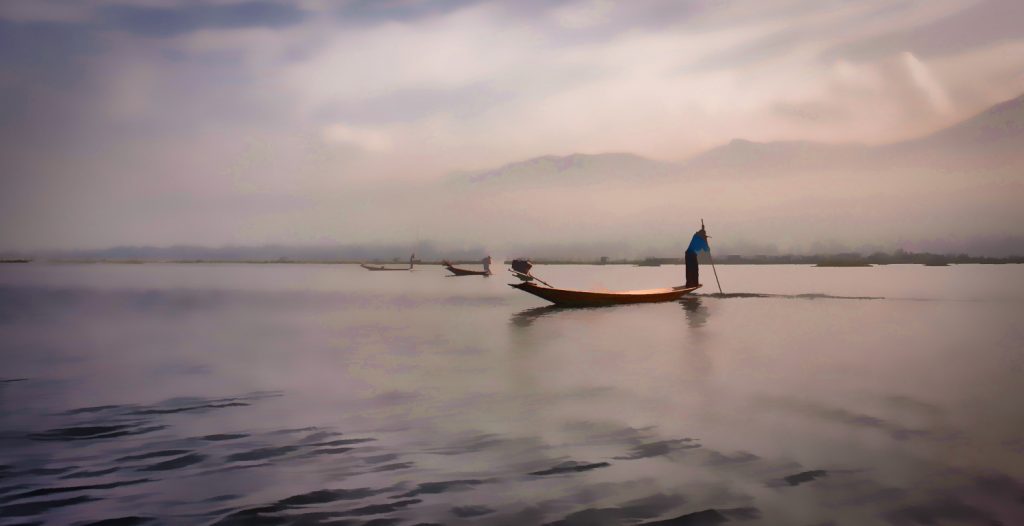A serene boat trip on Inle Lake, Myanmar
In Nyaung Shwe Nadya and I hired a narrow long boat to take us out on Inle Lake. The boat headed towards the shallow lake, out across the water. The boatman wore a white shirt and traditional Shan loose pants. He talked about going somewhere, but it was hard to hear what he was saying from the noise of the longboat engine.
We continued down the waterways of Inle Lake. Gliding down a feeder channel, we were able to see the floating gardens where villagers lived directly on the lake. A woman with a straw hat paddled a long canoe past the dock of a wooden platform.

Further on, a man with his trouser legs rolled up was dredging weeds from the lake bottom that he’d use in his garden. He grew tomatoes and cucumbers in a garden anchored to the riverbed by bamboo poles, the floating beds rising and falling with the change of water level.
I came away impressed by how the people had adapted to living on the lake. It was an intriguing glimpse of the lake dwellers going about their daily lives. A squatting man was brushing his teeth over the water while young children splashed and swam nearby. The stilt houses of the village were surrounded on all sides by water.

We drifted by a cluster of crumbling ancient pagodas made of mud and stone, a ruined temple in the overgrown grass and gilded stupa spires reaching to the sky.

Further out, men on a long boat were collecting seaweed to fertilize the floating gardens. Loaded down with mounds of dark seaweed, the boat was mere inches above the water. Against the backdrop of the Shan hills, we drifted up the shallow waters, puttering down a muddy canal with floating seaweed, threads of white clouds drifting above us in the blue sky.
Drifting towards the center of the lake, we admired an Intha fisherman, wearing a white shirt and beige pants, standing on the stern rowing. With his leg wrapped around the oar, he was in a better vantage point to spot fish and could use both hands for pulling them in.

In the distance an Intha fisherman, with one leg wrapped around an oar, was rowing smoothly across the lake, bringing in his catch. Balancing on one leg, the handle of the oar cradled in his armpit, he slapped the oar against the water to frighten the fish into the nets.

Later we stopped at a weaving workshop on stilts. The looms were clacking as we entered, the women weaving with thread made from the stem of the lotus flowers that grew on the lake. A woman in a towel-wrap headdress, her teeth capped with gold, was extracting the thread from the lotus plant by hand using a knife. She carefully trimmed around the stem and then pulled out the sticky and elastic fiber.
The threads were then spun together on a spinning wheel made from old bicycle parts by turning the pedals by hand. Three women were weaving the threads into intricate patterns on large wooden handlooms.

I didn’t know how they did it. It seemed such a complex technique weaving the fine threads into exquisite patterns just using old, rickety contraptions. In a small adjoining shop they sold beautifully patterned scarves, longyis and bags made from colorful lotus thread and silk.
Back in the boat, coming in through the narrow waterway, we passed beneath an arched bamboo bridge. We sputtered by an expanse of lavender water hyacinths and pink lotus flowers scattered across the reed patches. White egrets flighted above us as we came in sight of a magnificent pagoda. The famous multi-tiered Phaung Daw Oo enshrines the 800-year-old Buddha images that are revered in the region.

Nadya and I checked out the murals depicting the life of Buddha. Just as interesting were the photos hanging on the wall showing how the statues had looked in their original shapes. A sign written in English and Burmese read, Ladies are prohibited. Women had to stay well back from the centre shrine and observe from a distance. A man in the shrine rubbed a cloth strip across one of the gold lumps, which he would then tie to his bike or car for good fortune.








